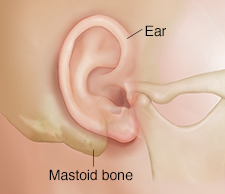Mastoidectomy
Mastoidectomy can remove infected bone and growths from the middle ear. But it may not always improve your hearing in the affected ear. The mastoid bone is located and can be felt behind the ear. During surgery, you'll get general anesthesia. The surgery may be done along with a tympanoplasty (eardrum repair) or an ossicular chain reconstruction (repair of the tiny bones behind the eardrum).

Infection and growths
The mastoid bone contains cells that hold air (called air cells). Problems occur when an ear infection spreads to the air cells. Skin cells may also build up in an infected ear. These skin cells can form a growth (cholesteatoma). This growth can destroy nearby bone. If not treated, mastoid bone problems may cause deafness, facial nerve damage, dizziness, brain infection, or even death.

Removing mastoid bone
To reach the mastoid bone, your surgeon makes a cut (incision) behind the ear. They may go through the ear canal. Both approaches may be used together. Infected bone and any growths are removed. Then the incision is closed with stitches. There are many types of mastoidectomy. Each type is based on the amount of infected bone. Your surgeon will explain why a certain approach is best for your situation.

Online Medical Reviewer:
Chris Southard RN
Online Medical Reviewer:
Marianne Fraser MSN RN
Online Medical Reviewer:
Ronald Karlin MD
Date Last Reviewed:
3/1/2024
© 2000-2024 The StayWell Company, LLC. All rights reserved. This information is not intended as a substitute for professional medical care. Always follow your healthcare professional's instructions.